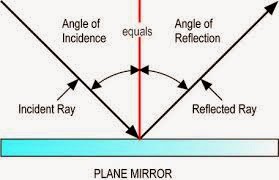However, the sources of light are known as luminous sources. Luminous source is a source of light that radiates light either naturally or artificially. Examples of luminous sources are sun, moon, stars, torchlight, candle, electric bulb etc.
Shadow was brought about due to the rectilinear propagation of light. Shadow is a region that light rays
do not reach due to the obstruction by an opaque object. Shadow consists of umbra and penumbra. Umbra is a region with the total darkness while, penumbra is the region with partial light rays.
 Light propagation rectilinear also causes a phenomenon known as eclipse. Eclipse occurs when the sun, the moon and the earth are collinear. When the moon is between the earth and the sun, solar eclipse ( eclipse of the sun ) is occurred. When the earth is between the sun and the moon, lunar eclipse ( eclipse of the moon ) takes place. Annular eclipse is formed when the moon's shadow is cast onto the earth's surface. Note, lunar eclipse occurs during the night while, solar eclipse occurs during the day.
Light propagation rectilinear also causes a phenomenon known as eclipse. Eclipse occurs when the sun, the moon and the earth are collinear. When the moon is between the earth and the sun, solar eclipse ( eclipse of the sun ) is occurred. When the earth is between the sun and the moon, lunar eclipse ( eclipse of the moon ) takes place. Annular eclipse is formed when the moon's shadow is cast onto the earth's surface. Note, lunar eclipse occurs during the night while, solar eclipse occurs during the day.Do you know the first camera on earth and when it was invented? The first camera is the pin hole camera, it was invented in 1550. It consists of a box at one end with a pin hole at the other end. When an object is placed in front of the pin hole, its image is inverted and seen on the screen. The closer the object to the pin hole, the larger and blurrier the image. While, the farther the object from the pin hole, the smaller and sharper the image. Note, the size of the image increases as the hole increases.
 | ||
- First Law Of Reflection: This law states that the incident ray, the reflected ray and the normal all lie on the same common plane.
- Second Law Of Reflection: This law states that the angle of incidence is equal to the angle of reflection, provided the reflection on a smooth surface.
Types Of Images
There are two types of images - the real image and the virtual image- Real images are images that light can pass through it. If a screen is placed at the position of the image, it can be seen.
- Virtual Images are images that light cannot pass through it but can be seen by the eye. Dear, the image formed on a plane mirror is a typical example of a virtual image.
- It has the same size as its object.
- It is upright and erect.
- It is a virtual image.
- It is laterally inverted.
 |
| A kaleidoscope |
 |
| A sextant |
 |
| RIGHT: Convex mirror; LEFT: Concave mirror |




No comments:
Post a Comment